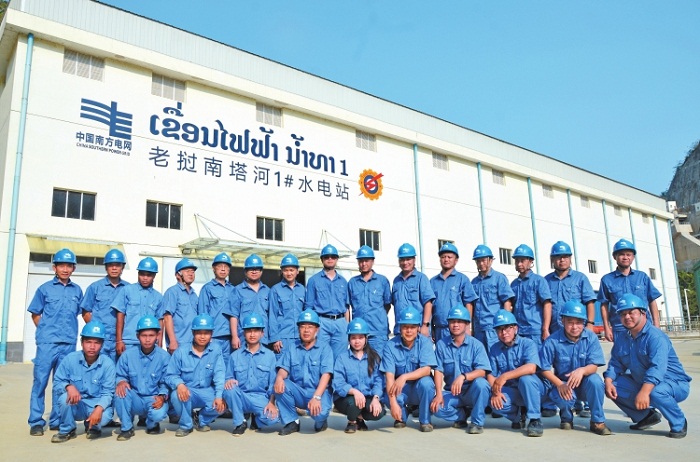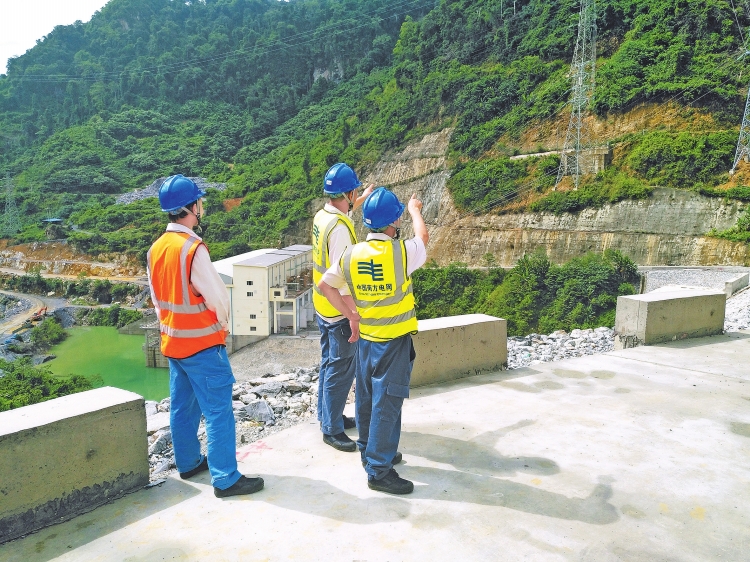from:China Southern Power Griddate:2019-06-18

The operational and maintenance team from Nam Tha Project Department of the International Project Management Center of Lubuge Hydropower Station

On May 23, 2018, workers onsite in Laos conduct safety inspections during the early-stage work on the Nam Tha Project Department
Nam Tha, Laos - It is around midnight and the mountains and hills near the Tha River are shrouded in darkness.
On the banks of this beautiful river, a newly-launched hydropower station is brightly lit and workers from China Southern Power Grid are busy here, lighting up the night in Northern Laos with a steady stream of “green-originated” electrical power.
In the eyes of the Lao people, the workers from CSG are true friends, tutors and seasoned experts. They all hail from the operation and maintenance team of the Overseas Project Management Center of Lubuge Hydropower Station run by the CSG Peak Frequency Modulation Company.
“At the beginning, I was not used to the tropical rain forest climate of this place, but later, I adapted to the lifestyle and the way of production here, and now I have fallen in love with it,” said Zhu Pengcheng, safety inspector from Nam Tha Project Department of the Overseas Project Management Center.
In August 2016, as a member in the group for early-stage work, Zhu arrived at the site of the Nam Tha project to participate in the work of electromechanical installation.
He has been stationed here for the past three years.
Equipped with years of experience in operating and maintaining hydropower stations, the Overseas Project Management Center of Lubuge Hydropower Station has dispatched numerous technicians for the operation and maintenance of the two power stations, located in Banglang and Yanwa, Myanmar.
In August 2018, staff and senior management of the Center took over the operation and maintenance of the Nam Tha 1 Hydropower Station and opened a new journey for China Southern Power Grid to operate and maintain internationally-based power stations.
First Days on the Nam Tha
Jiao Yi, 32, assistant technical expert of Nam Tha Project Department, came to Laos and joined the Nam Tha 1 Hydropower Project in July 2018. It was his first time to visit a foreign country and he had never expected that his journey would be so tough.
On the way to his final destination, the car he was riding broke down on a mountainside, deep inside the virgin forest, and his cell phone lost its signal.
He and his companion, Fang Nanyun, deputy director of the same department, had to trudge through the wilds of the forest to find a cell tower signal. Finally, they climbed to the top of a mountain and successfully contacted their colleagues at the Nam Tha 1 Hydropower Station.
One month after Jiao’s departure from China, Ran Yong, safety inspector of the department, travelled with his colleagues by car for three straight days … from Luoping to the Nam Tha 1 Hydropower Station.
The average age of the travelers was 48, all of whom were experienced technicians.
The Nam Tha 1 Hydropower Station was badly in need of qualified technical personnel, while the Lubuge Hydropower Station is quite experienced in this field. The former’s demand and the latter’s supply of related technology and experience made for a perfect match.
That was why these veteran technicians started their journey for this important project along the Belt and Road.
After they arrived at the Nam Tha 1 Hydropower Station, the technicians realized that the tough native conditions were beyond their imagination.
The station is to the south of the Tropic of Cancer with temperatures surpassing 40 degrees Celsius all year round. Cuts in water supplies, intermittent internet connection and cell phone signals are commonplace here.
The surround area is lush … but desolate.
The nearest village is three kilometers away and the residents there live what most city dwellers would think is primitive lifestyle.
Snakes, lizards, and crickets are everywhere. Sometimes snakes may even slither their way into the workers’ room at the most awkward of times.
In the face of this challenging new environment and unfamiliar equipment, the technical group had to start a whole new life.
During their first days at Nam Tha, besides optimizing equipment, they had to overcome the harshness of the working environment while their work was constantly challenged by dust and insects.
"Although the Nam Tha Power Station is small, the work here has never been easy. The Project Department here is doing what should be done by the all of the departments of a power station. We pushed ourselves even harder than when we were working at Lubuge Hydropower Station,” says Zhao Xiaokun, director of the Nam Tha Project Department, adding, “that’s why the workload of the overseas workers here is almost two to three times that of the ones at home."
All of the technicians brought the high standards of quality and excellence of China Southern Power Grid to the Nam Tha project. To them, it is not only a matter of mission by the company but a matter of honor and respect of the Motherland to successfully manage the Nam Tha 1 Hydropower Station.
Ran Yong has worked for the Lubuge Hydropower Station for more than three decades. He recalls a story that has been lingering around for years.
It was in 1992 when the Lubuge Hydropower Station was completed and as the foreign experts were leaving, they asked, “are you sure your team can run it well after we leave?”
“The situation in Laos is now very similar to that in Yunnan in the 1990s. The demand for electricity is high, while the technology many times does not meet the needs of the regional community. So, some already built power stations need to entrust third-party operation and maintenance management,” said Cang Yong, engineer.
Today, Ran Yongs’ outstanding work performance and decades of first-line experience set him apart for this important international work assignment. He thinks of it like a cycle. In the past, he had to learn and borrow equipment and technology from other countries.
But today, he is carrying the equipment created in China and taking its advanced technology to faraway places around the globe.
Even if the working and living conditions are tough, the technicians here are still full of enthusiasm. They have a strong sense of pride and responsibility and are working hard to serve the Belt and Road Initiative.
Settling in at the Hydropower Station
The Nam Tha Project Department of Lubuge Hydropower Station has designed 15 safety production management systems, including: safety production responsibility systems, equipment defect management, reservoir management and seven administrative management systems on several aspects such as working shifts and drawings.
These and many more efforts combine to ensure the smooth operation of the Nam Tha 1 Hydropower Station that came online on October 26, 2018.
On that date, the Nam Tha 1 Hydropower Station achieved a 72-hour full-load trial operation, marking the full-swing operation of the station. Its power generation capacity can reach 721 GWh per year, which provides “green” electrical power to more than two million people in Northern Laos.
Empowering the local technicians
It is often the case in the past that Chinese staff members at the Lubuge Hydropower Station had to depend upon themselves to learn how to operate the equipment after the contracted foreign experts had finished their mission and carried with them the technology back to their home countries.
Such challenges are hard to bear.
As Chinese staff members have today become the Lao people’s international experts, they go to great lengths to equip the people with their own cutting-edge technology so that they can one day run the station by themselves.
“We have passed along all technological expertise to the Lao staff without reservation and we have tried our best to teach, mention and guide them along the way,” said Zhao Xiaokun, adding “only after experienced Lao staff emerge can we leave the station with them.”
However, it’s never an easy job to train them to be fully competent in operating the station.
Starting on July 30, 2018, five Lao staff accompanied Chinese technicians to operate and maintain the station. All of them have received their technical education in China. It’s not their Chinese language proficiency but their limited knowledge in electrics that have worried Zhao Xiaokun.
In Lao staff’s views, Zhao is a serious teacher, who always challenge them as students with questions about circuit diagrams of generators, such as “Where is it? Can you take me to that place?”
“We have taught them to our best ability and they have made great progress in distinguishing different facilities by observing the circuit diagram,” said Zhao.
The Lao staff has gradually acquired more knowledge on the station’s facilities as a result of the careful training given by the Chinese experts from the operation and maintenance team of the Nam Tha Project Department.
Zhu Pengcheng, 57, is in charge of safety inspection and his teaching style is more “restrained” than his contemporaries. He uses different methods to challenge his students in consolidate their knowledge and was afraid that when he retires, he will not be able to return home in the comfort of knowing his students are fully prepared.
This training process has been beneficial to the Chinese instructors as they acquired a strong working understanding of Lao language and unique culture from their students.
In the evening, a Lao language salon was held at the station. Its relaxed atmosphere continues to relieve the Chinese staff of their shyness and speak freely in the local Lao dialect.
At the moment, Lao employees who are students during the day have they themselves become teachers and work to inspire Chinese staff to learn Lao words while gaining an understanding to local customs.
Twenty three year-old Vilay is one of the Lao employees, who studied the operation and management of hydropower stations in Yellow River Water Conservancy Technical Institute in Kaifeng, Henan Province.
Today, Vilay has become adjusted to the work and life at the station.
Protection from catastrophic floods
“While we are helping Laos to build projects, we should also pay attention to protecting local people’s property from losses,” said Zhao Xiaokun, who repeatedly stresses the need for advance preparations.
Zhao has been a stalwart of and inspiration for all staff members in the Nam Tha Project.
In July 2018, Typhoon Mangkhut impacted all parts of Laos, causing heavy rainfall in many areas and surging water levels in the rivers nearby the hydropower station.
Many parts of Laos were stricken by severe flooding.
Lao's rainy season has seen heavy rainfall. However, unlike China's hydropower stations, which have relatively developed hydrological measurement systems, stations in Laos often hinge on their staff to observing the situation with “naked eyes”, thus requiring employees to take turns on 24 hour shifts to estimate the incoming water by looking at changes to the water gauges.
What puts the Nam Tha Project under extreme pressure are some equipment breakdowns.
“Theoretically speaking, the project can drain 6,000 cubic meters per second. But in practice, if the facility drains about 1,800 cubic meters per second, the villages downstream will be submerged,” said Wang Zhiqiang, Vice Monitor.
The operation and maintenance team follow the water regime team’s instructions to operate the gate as the experienced water regime team estimates the inflow.
This has been a perfect collaboration.
Though they were quite nervous, the staff managed to drain all of the flood waters of which the discharge takes place at night. While arranging the workload for the night shift team, the monitor found those staff who worked during the day and were supposed to take a rest were also present.
“We will work with the whole team in case of emergency,” said Wang.
As Typhoon Mangkhut passed, the Nam Tha 1 Hydropower Station survived the challenges caused by the catastrophic flooding which bought precious time for the downstream villages to shore up their homes.
When the rainfall comes this year and beyond, Lao residents in the lower reaches of the power can rest assured that China Southern Power Grid staff and instructors have served them well!
Tel:+86-25-84152563
Fax:+86-25-52146294
Email:export@hbtianrui.com
Address:Head Office: No.8 Chuangye Avenue, Economic Development Zone, Tianmen City, Hubei Province, China (Zip Code: 431700) Nanjing Office: Room 201-301, Building K10,15 Wanshou Road,Nanjing Area, China (Jiangsu) Pilot Free Trade Zone,Jiangsu Province,China (Zip Code:211899)
